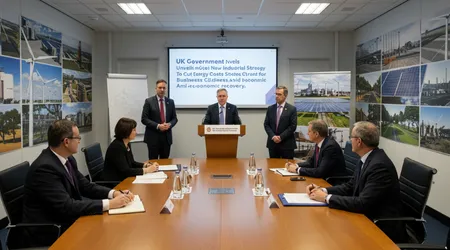UK Government Unveils New Industrial Strategy to Cut Energy Costs for Businesses Amid Economic Recovery

The industrial strategy to cut energy costs for businesses, launched on June 23, 2025, marks a pivotal moment for the UK’s economic revival.
Under Prime Minister Keir Starmer’s leadership, this 10-year plan promises to slash electricity bills for over 7,000 companies by up to 25% from 2027, targeting energy-intensive sectors like steel, automotive, and chemicals.
With the UK economy grappling with a 0.3% contraction in April 2025, driven by global tariffs and domestic tax pressures, this strategy aims to restore competitiveness and spark long-term growth.
By addressing sky-high energy costs a persistent barrier to industrial success the government seeks to reposition Britain as a global investment hub.
But can this ambitious blueprint deliver tangible results in a volatile economic landscape?
This strategy arrives at a critical juncture. Manufacturers face some of the highest electricity prices in the developed world, hampering their ability to compete with EU and US rivals.
The plan’s focus on energy cost relief, coupled with investments in clean energy and digital innovation, signals a pragmatic approach to economic recovery.
Beyond energy, it tackles skills shortages and grid connection delays, offering a holistic vision for industry.
This article dives into the strategy’s key components, its implications for businesses, and the challenges it must overcome to transform the UK’s industrial landscape.
A Game-Changer for Energy-Intensive Industries
The industrial strategy to cut energy costs for businesses centers on the British Industrial Competitiveness Scheme, a flagship initiative to reduce electricity bills.
From 2027, over 7,000 firms will benefit from exemptions on green levies, such as the Renewables Obligation, which fund renewable energy projects.
This could save manufacturers up to £40 per megawatt-hour, a lifeline for sectors like steelmaking, where energy costs can account for 11-25% of total expenses, according to Make UK.
Energy Secretary Ed Miliband emphasized the urgency of reform: “High electricity costs have held back British businesses due to reliance on volatile gas markets.”
The strategy also boosts the British Industry Supercharger, increasing discounts on network charges for 500 energy-intensive firms from 60% to 90% by 2026.
For example, a steel plant in Sheffield could see its annual energy bill drop significantly, enabling reinvestment in modernization or job creation.
Yet, the two-year consultation to determine eligibility raises concerns. Businesses like ceramics manufacturer Potter & Clay, struggling with rising costs, may face delays in relief.
++ Blaise Metreweli Appointed as MI6’s First Female Chief in 116-Year History
Critics argue this timeline risks undermining the strategy’s momentum. Will firms survive long enough to reap the benefits?
The government insists funding will come from energy system reforms, not taxpayers or household bills.
Linking the UK’s Emissions Trading Scheme with the EU’s could stabilize carbon pricing, fostering cross-border investment.
This pragmatic approach balances net-zero goals with industrial needs, but clarity on funding remains elusive.

Accelerating Grid Connections for Growth
Grid connection delays have long stifled industrial expansion.
The industrial strategy to cut energy costs for businesses introduces the Connections Accelerator Service, launching by late 2025, to fast-track access for high-value projects.
This service prioritizes developments creating skilled jobs, such as a new battery factory in Sunderland, over less strategic initiatives.
Pending legislation in the Planning and Infrastructure Bill could reserve grid capacity for critical projects, slashing wait times.
Currently, some firms face delays of up to seven years for grid access, stifling investment. The strategy’s focus on electricity networks as “foundational” to clean power ambitions underscores its forward-thinking approach.
Also read: Public Transport Price Hike: How It Will Affect Commuters
However, the strategy’s success hinges on execution. Local authorities and energy firms must align to deliver the Accelerator Service effectively.
For instance, a data center in Slough, classified as critical infrastructure in 2024, could benefit, but only if bureaucratic hurdles are cleared.
Without swift implementation, the promise of faster connections risks becoming another missed opportunity.
Skeptics question whether the government can deliver on such ambitious infrastructure reforms. Past delays in grid upgrades suggest coordination challenges.
The strategy’s emphasis on collaboration with Scottish and Welsh governments offers hope, but tangible progress will define its legacy.
Investing in Skills and Innovation
Beyond energy, the industrial strategy to cut energy costs for businesses tackles the UK’s skills crisis. Manufacturers cite workforce shortages as a top challenge, with 43% of firms struggling to recruit skilled workers, per a 2024 CBI survey.
The plan allocates £275 million to train Britons for industries like advanced manufacturing and clean energy, reducing reliance on foreign labor.
Five new professional business services hubs in England and Scotland will support sectors like accountancy and AI adoption.
For example, a tech startup in Manchester could access subsidized AI training, boosting productivity. The strategy also commits £2 billion over four years to R&D, targeting AI and advanced manufacturing.
Yet, upskilling takes time. Firms like GreenTech Solutions, a wind turbine manufacturer, need skilled engineers now, not in five years.
Read more:How to Move to the UK: A Step-by-Step Guide
The strategy’s long-term vision may clash with short-term labor demands, risking bottlenecks. Critics argue the £275 million investment is modest compared to the scale of the challenge.
The government’s plan to negotiate mutual recognition of professional qualifications with other nations could ease talent shortages.
By 2035, this could create 1.1 million skilled jobs, transforming regions like the West Midlands. However, without rapid rollout, businesses may continue to struggle.
Mutual recognition agreements could also boost exports. A UK architect, for instance, could work seamlessly in Canada, expanding opportunities.
The strategy’s focus on innovation and skills positions the UK for global leadership, but execution will be critical.
Economic Context and Global Competitiveness
The industrial strategy to cut energy costs for businesses responds to a fragile economic outlook.
The UK’s GDP contracted by 0.3% in April 2025, hit by US tariffs under President Donald Trump and domestic tax hikes. Manufacturers, squeezed by rising national insurance contributions, demand relief to stay competitive.
The strategy’s energy cost reductions aim to level the playing field. UK manufacturers pay electricity prices 50% higher than German counterparts, per a 2024 Make UK report.
By exempting firms from green levies, the government seeks to close this gap, making Britain an attractive investment destination.
Global trade shifts add urgency. US tariffs threaten UK exports, while EU competitors benefit from integrated energy markets.
The strategy’s plan to explore UK participation in the EU’s internal electricity market could lower costs further, but Brexit sensitivities complicate negotiations. Can the government navigate these diplomatic waters?
Businesses like automotive supplier DriveTech, facing tariff-driven cost spikes, welcome the strategy but seek immediate relief.
The two-year wait for energy savings could push some firms to relocate. The strategy’s success depends on bridging this gap with interim support.
Balancing Net-Zero and Industrial Growth
The industrial strategy to cut energy costs for businesses walks a tightrope between net-zero ambitions and industrial competitiveness.
Scrapping green levies for manufacturers risks criticism from environmentalists, yet the government insists reforms align with clean energy goals.
Doubling clean energy investment to £30 billion annually by 2035 underscores this commitment.
Energy-intensive firms, like glassmaker CrystalWorks, could reinvest savings into low-carbon technologies, aligning with net-zero.
The strategy’s Industrial Growth Plan for electricity networks supports this transition, prioritizing renewable infrastructure. However, vague funding details spark skepticism.
Critics like Caroline Bragg of the Association of Decentralised Energy argue that only select firms benefit, sidelining smaller businesses outside industrial clusters.
A bakery in Cornwall, for instance, faces rising energy costs without relief. The strategy must broaden its reach to avoid regional disparities.
The government’s carbon pricing reforms, funded through a strengthened UK Emissions Trading Scheme, aim to sustain net-zero progress.
Yet, without transparent funding models, businesses and voters may question the strategy’s viability. Clarity is essential to maintain trust.
Challenges and Opportunities Ahead

Implementing the industrial strategy to cut energy costs for businesses faces hurdles. The two-year consultation delays relief, risking business closures.
Coordination across government, industry, and local authorities is vital but historically fraught. Past infrastructure projects, like HS2, highlight execution risks.
Business groups, including the CBI, praise the strategy’s ambition but demand accountability. “This is a long-overdue response to industry’s voice,” said Rain Newton-Smith.
Yet, concerns persist about the Employment Rights Bill, which could raise labor costs, offsetting energy savings. The government must address these contradictions.
Opportunities abound. The strategy could transform regions like Wales, where new manufacturing jobs could revive communities.
A wind farm project in Anglesey, backed by grid investments, exemplifies this potential. By 2035, the plan aims to unlock billions in investment.
The global race for clean energy and digital leadership offers a chance for Britain to shine.
With strategic execution, the UK could become a hub for green manufacturing, attracting firms like Tesla. However, failure to deliver risks eroding business confidence.
The industrial strategy to cut energy costs for businesses is a bold vision. It promises to reshape the UK’s economic future, but its success hinges on swift, transparent action. Will the government rise to the challenge?
| Key Metrics of the UK Industrial Strategy (2025-2035) | Details |
|---|---|
| Businesses Benefiting from Energy Cost Relief | 7,300+ |
| Electricity Bill Reduction Target | Up to 25% |
| Start Date for Energy Savings | 2027 |
| Jobs Created (by 2035) | 1.1 million |
| Clean Energy Investment (Annual by 2035) | £30 billion |
| R&D Spending (2025-2030) | £22.6 billion |
Conclusion: A Turning Point or a Missed Opportunity?
The UK’s industrial strategy to cut energy costs for businesses is a bold response to economic headwinds. By targeting energy costs, skills, and infrastructure, it offers a roadmap to for competitiveness.
From Sheffield steel plants to Manchester tech hubs, the potential for transformation is vast. Yet, challenges loom delays, funding ambiguity, and execution risks threaten progress.
This strategy could redefine Britain’s industrial heartlands, creating 1.1 million jobs by 2035. Like a ship navigating stormy seas, it requires steady leadership to reach port.
Businesses, desperate for relief, watch closely. Will this be the turning point Starmer promises, or another policy lost to bureaucracy? Only time will tell.
The government must act swiftly to maintain trust. Clear communication and interim support are crucial to bridge the gap to 2027.
With global competition intensifying, Britain cannot afford to falter. This strategy is a chance to lead, but it demands bold, decisive to succeed.
Frequently Asked Questions
What is the UK’s industrial strategy to cut energy costs for businesses?
It’s a 10-year plan launched in 2025 to reduce electricity bills by up to 25% for over 7,000 businesses, boost investment, and create jobs.
When will businesses see energy savings?
Savings start in 2027, after a two-year consultation, though some network charge discounts increase from 2026 for 500 firms.
How is the strategy funded?
Through energy system reforms, including a strengthened UK Emissions Trading Scheme, without direct costs to households or taxpayers.
Which sectors benefit most?
Energy-intensive industries like steel, automotive, chemicals, and glass, plus advanced manufacturing, clean energy sectors.
What are the risks?
Delays in implementation, funding uncertainty, and potential conflicts with policies like the Employment Rights Bill could undermine impact.
